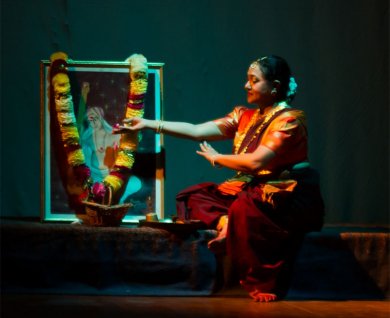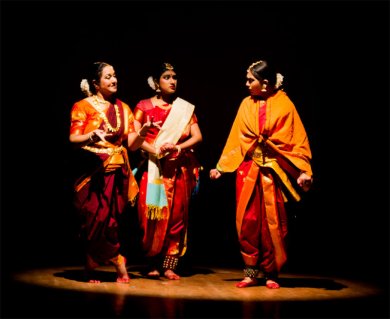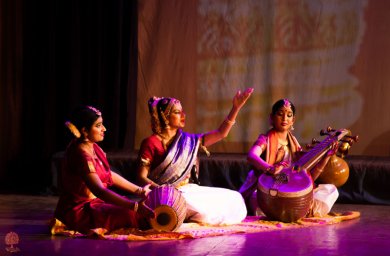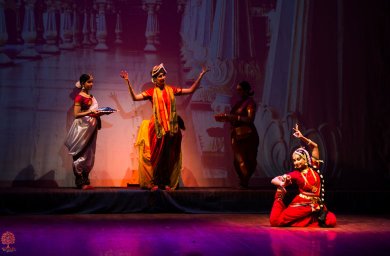
|   |

|   |
 e-mail: leelakaverivenkat@gmail.com Devadasi's legacy to the saint poet's glory Photos courtesy: India Heritage Desk April 9, 2018 It is almost ironical that dancers today celebrate the glory of Nagarathnamma, who from the thirties to 1947 (she died in 1952) led a dogged fight against the anti-devadasi movement, which deprived an entire community of its centuries old artistic credentials. Not knowing what to expect of Nagarathnamma- Pancharatna Pancharasam Natya conceived and choreographed by Kanaka Sudhakar of Sunaina, premiered at Delhi's Tamil Sangam auditorium, one must admit to being very pleasantly surprised at the laudable effort. Featuring Kanaka Sudhakar with her disciples, the production testified to great pains taken to capture the period details with backdrops of the Mysore court, the typical turbans worn at the time, sarees draped in the Karnataka style, with suitable jewellery etc. One very heartening feature was the uniformly well trained dancers.   Historically, the work aimed at capturing Nagarathnamma's legacy as Tyagaraja Seva Saktha, a title bestowed on this ardent devotee of Tyagaraja, who became known for travelling with her specially designed collapsible Thambura to fulfil singing assignments. Born to a Mysore advocate Subba Rao and a devadasi Puttulakshmi in 1878, the opening scene concerned child Nagarathnamma with her exceptional talents as dancer/singer being trained in Tamil, Telugu and Sanskrit under Guru Giribhatta Timmaiyya Sastri, a Sanskrit scholar, in Carnatic music under Muni Swamappa and dance under Guru Kittanna, the presentation featuring the phenomenally gifted child artiste Kanika Bhat, who was an absolute delight in her dance and histrionic talents. On this, the 250th anniversary of Tyagaraja, the production sought to capture Nagarathnamma the singer with the dance work based on the Pancharatna Kriti-s (the singing of which marks the annual Tyagaraja Aradhana at the Samadhi for this phenomenal vaggeyakarar, which this devadasi, with a missionary zeal helped make orderly) though historically, dancing to Tyagaraja Kritis is a post-devadasi development. One of the Pancharana Kritis, Tyagaraja's Sri ragam Endaro Mahanubhavulu comprised the impressive group start. The Tyagaraja adoration and Nagarathnamma's extraordinary legacy of the Samadhi she had constructed along with organisation of the annual Aradhana was no doubt a very vital achievement of Nagarathnamma. But this woman, a considerable Sanskrit scholar was also a spirited revolutionary feminist who boldly removed the ban on devadasi Muddupalani's book of verses Radhika Santvanam (which was fleetingly visualised as a war between purists who objected to the eroticism of the work and the more informed who maintained that the book was the acme of sringar rasa in depiction of Radha/Krishna love). As a cultural activist, Nagarathnamma waged a spirited fight against the anti-nautch movement along with other prominent devadasis like Veena Dhanammal, her daughters T. Rajalakshmi and T. Lakshmiratnam, Salem Meenakshi and Mylapore Gowri Ammal. This main part of this devadasi's life was not touched upon - with the Tyagaraja emphasis of the production. With violinist Venkitasami Appa presenting Nagarathnamma's dance in 1893 (by which time her mother had passed away) at Veena Sheshanna's (an artist of the royal court) place, Nagarathnamma very soon, as a bare 15 year old, was asked to perform at the Mysore Court before Raja Jaya Chamarajendra Wodeyar. The dancer performing a long Kriti like Sadinchine in Arabhi, subtly in the charanam line referring to Krishna's silver tongued talk fitting the occasion (Samayaniki taku matalade ne) danced with her back to the Raja. A better stage positioning with an angled profile for both royalty and dancer, could have worked. At the invitation of Rajaratna Mudaliyar, Nagarathnamma shifts to Chennai where she acquires a mansion as residence. The dream sequence has Nagarathnamma seeing in her mind's eye, Tyagaraja singing Dudugu gala in Gaula, in homage to Rama. The song regrets the lack of realisation that only in singing Tyagaraja's songs in praise of the Lord lies salvation. This long composition needed to be treated differently to make the scene less tedious. Lights playing on the now mature devadasi's reclined figure (played by Kanaka Sudhakar herself) on a higher level of the stage with some shots of a group visualising the song, in constant play with the squatting figure of Tyagaraja singing in front of a large portrait of the Lord or some such diversion was sorely needed, because one understands that it would go against the maryada of the piece to treat only sections of the Kriti.   Appalled at the condition of the site where Tyagaraja was laid to rest, Nagarathnamma, in order to build a proper Samadhi, sells her Chennai mansion and also much of her jewellery. With the proceeds, she cleans and constructs temple and the Samadhi, her sacrifices finally making the rival groups of the Periya Katshi and Chinna Katshi (big group and small group) rise above their petty differences, to present the singing of the Pancharatna Kriti-s at the Tiruvaiyaru site on Tyagaraja's Aradhana Day. And so it continues to this day. The choreography visualising this sequence of construction, in a neat semicircle, needs rethinking, for it looked very artificial and least like building activity. Tyagaraja's Kanakana ruchira kanaka vasana ninnu in Varali had a group rendition, the composer's desire for constantly feasting his eyes on the majesty of Rama, his beauty, the way his side loving glance is directed at Sita, how Dhruvan on hearing the cruel words of his step-mother, found comfort and peace in praying to Rama - the Lord worshipped by Hanuman, by Narada, by Parasara, by Sukha, by Indra, by Parvati, by Sita. The dance ensemble with Aparajita Sarma, Arti Raman, Tanya Gambir, Anusha Ramachandran, Shrutika Narang, Lucienne Lavanya, V. Saradyuthi, Nanina Bhatt led by Kanaka Sudhakar combined well. The sole male dancer V. Ramana acquitted himself well. It was a good idea to record the music with vocalists K.Venkateshwaran, Sowmya Gurucharan, Akshaya and Srilakshmi and Tanjavur R. Kesavan providing mridangam and khanjira accompaniment. Munikondan Ramesh and Chembai R. Srinivasan were on veena and violin respectively. On the octopad was Manmohan Singh Bhatia, and Kishor Malhotra on keyboard. The narrative bits too with dialogue were neatly managed with Vasudevan Iyengar, Kanaka Sudhakar, Meena Venky and Anusha Ramachandran. Some of the lip synching movements and imitative gestures to show instrument playing could be improved upon. But with time and experience through repeated renditions this will get better.  Writing on the dance scene for the last forty years, Leela Venkataraman's incisive comments on performances of all dance forms, participation in dance discussions both in India and abroad, and as a regular contributor to Hindu Friday Review, journals like Sruti and Nartanam, makes her voice respected for its balanced critiquing. She is the author of several books like Indian Classical dance: Tradition in Transition, Classical Dance in India and Indian Classical dance: The Renaissance and Beyond. Post your comments Please provide your name and email id when you use the Anonymous profile in the blog to post a comment. All appropriate comments posted with name & email id in the blog will also be featured in the site. |